By Hedy Korbee
Imagine if a fire broke out in Birch Cliff west of Warden, south of the railway tracks, and swept southeast all the way to the foot of Birchmount Avenue where it meets Lake Ontario.
That’s exactly what happened on March 28, 1910, when Birch Cliff was still a hamlet with a population of a few hundred people living in farms and summer homes.
It was a brushfire that devoured 200 acres of land at a time when there was no running water and the nearest fire hydrant was two miles away at what we now know as Malvern Collegiate.
And it happened 15 years before the iconic Scarborough Fire Hall #1 was built on Birchmount Avenue, north of Danforth Avenue.
The drama was captured with sensationalistic enthusiasm in the pages of the Toronto Evening Telegram, complete with bucket brigades, tales of heroism, and fainting women conjuring the spirit of Laura Secord.
The Telegram (1876 – 1971) has never been digitized. This piece of history has been preserved by the staff at the Taylor Memorial Branch of the Toronto Public Library and the story has been transcribed below.
Like a Prairie Fire Flames Swept City’s Borders
Men, Women and Children Fought Blaze that Threatened Birch Cliff
________________
PLOUGH AND SPADE HELPED
________________
Women Fainted at the Work of Fire Fighting, But Went at It Again as Soon as They Revived — The Damage, in the Two Mile Swath of Fire, is $20,000.
Damage — $20,000.
Line of fire — Commenced near G.T.R. tracks, spreading south to lake shore, a distance of nearly two miles. Fully two hundred acres swept.
Nearest fire hydrant – East Toronto High school, two miles away
Buildings destroyed — Several barns burned to ground, but houses saved.
HOW FIRE WAS FOUGHT
Men, women, boys and girls formed bucket brigades with Kew Beach and East Toronto firemen and fought fire with buckets of water, brooms, branches of trees, spades, and clothing, and plows.
CAUSE OF IT ALL
Either a spark from a railway engine or tramps starting a fire in the woods.
~~~~~~~~~~~~~
Birch Cliff, a new city colony on the Kingston road three miles east of Yonge street, experienced the worst conflagration in its history yesterday afternoon.
Fire swept with lightning speed for a distance of two miles in length and in places nearly a half-mile in width.
After traveling a distance of nearly a mile before it was noticed, the flames swooped down upon the barns belonging to Mr. East, of East & Company, Yonge Street, laying them in a heap of ashes. The united efforts of hundreds of neighbours save his fine summer residence to the south of the barn.
SWEPT TOWARDS COTTAGES
Flying embers from the burning burns were carried across the street by the high wind and while the fire fighters were saving the house the dry grass and shrubbery across the roadway took fire and fanned (unintelligible) rapidly towards the lake shore where several other cottages were but were saved from the devouring flames in the nick of time.
WHERE BLAZE STARTED
Shortly after twelve o’clock yesterday afternoon the bush south of the Grand Trunk railway tracks was noticed to be on fire but no particular attention was paid to it, as there were no houses or barns in the immediate vicinity. Fanned by the high wind on Scarborough Heights, the small blaze, unnoticed at first, crept gradually into a roaring fire.
Licking up a large patch directly south-east, the fire swept on towards Mr. Brown’s residence, a short distance north of the Kingston road, and, Mr. East’s residence, a short distance east. The two were in danger of being laid in ashes.
A LITTLE HEROINE
Miss Hattie Viancour, sixteen years of age, saw the flames creeping up towards the residence, and lost no time in notifying a nearby resident, and then having the alarm sent to the Kew Beach and East Toronto firemen.
By the time the alarm was given throughout the district, and assistance arrived, the flames had eaten their way through the bush at the rear of the East residence, and almost in an instant the barns and henneries consisting of four buildings, were a roaring furnace, and the Brown residence was endangered.
WOMEN FIRE FIGHTERS
Men, women, boys and girls worked like Trojans around the two residences and after an hour’s battle or more both houses were saved, but the barns, henneries and bush were wiped clean, just a dark ashen path remaining to tell where the blaze had swept its way.
Laura Secord may be dead in the body, but in the saving of Mr. Brown’s residence her spirit still reigned supreme in the brave women who fought until they dropped in their tracks unconscious. and when brought to by other workers fought on, until their last effort were crowned with success.
ONE RESIDENCE SAVED
When the fire swept down the Kingston road to Mr. Brown’s little cottage built in the woods, and of most inflammable material some tarpaper, a fight as for life and death took place.
Men formed themselves into bucket brigades, armed with anything that would hold water. Women and men took branches, beating the fire out. Others used spades, digging trenches to prevent the fire from spreading.
TWO WOMEN FAINTED
While the men were battling the flames Mrs. Helmkay and Miss Elma Hopkins carried water from a neighboring well a half a mile away. Both women had been fighting the fire until they were almost ready to drop from exhaustion when they went after water for the men.
“I worked as hard as I could to prevent the flames from spreading,” stated Mrs. Helmkay to The Telegram yesterday afternoon. “Part of the time I was shoveling with a space to prevent the fire from travelling any further and part of the time i was beating the small blazes out with branches and a broom.
“After I had been fighting the fire for a while I went for water for the men. I had to go about a half mile for it,” she went on pointing at the same time to a nearby farmhouse, “and I could only carry one pailful of water at a time.”
“I was coming back with water and hurrying along with my load when I fainted away. It was the first time that i ever fainted in my life. I am made of pretty good stuff, but i had to go far for the water.”
“Miss Emma Hopkins, who was working with me digging and carrying water, also fainted away. As soon as we came to we did not stop work. We heard that Mr. Phirrell’s house was on fire and rushed down to see. The flames were only a short distance from the house. We beat out the fires and saved the house. I guess if we hadn’t been there the house would have burned down.”
FIGHT TO SAVE A HOUSE
At the same time a terrible fight was being put up to save the residence of Mr. East. Following the burning of the bars, the house had a narrow escape.
“I was first to see the fire back of the barns,” stated Miss Hattie Viancour, “and it was travelling right toward the barns then. I gave the alarm and a number came to assist in putting out the fire.
“Irene Sheppard and I had branches and helped to fight the fire in the field. It was an awful sight to see, and we work as hard as we could and pulled straw out of the barn.”
FOUGHT LIKE TIGERS
“I never saw anything like it,” stated Mr. George F. Davis while he watched the ashes of the barn smouldering and the bush burning in the distance. “The fire was first discovered back of the barn, and in a short time with the high wind it was soon beyond control. It was terrible, and if it had not been for the assistance of the East Toronto and Kew Beach fire brigades Birch Cliff certainly would have been wiped out of existence. They fought like tigers.”
“The women and girls in the neighbourhood found hand with brooms and turned in and did men’s work. Mrs. Young and Mrs. Sheppard, neighbours had booms and did grand work.”
FIREMEN ON THE JOB
By the time the Kew Beach and East Toronto firemen were on the scene the barns were practically destroyed. Handicapped with the absence of water, the firemen turned in and fount with spades, brooms, branches of trees and buckets, the same as the rest.”
Flying embers from the barn caught the grass and bush across the street and the city firemen gave most of their attention to the savings the summer cottages along the lake shore and were entirely successful, although the residence of Mr. Farlane was slightly scorched.
During the early part of the afternoon, Kew Beach and East Toronto firemen had worked until tired out on the Ames bush fire. Without their dinner or a rest they answered the call to Birch Cliff and fought almost until supper time.
PLOUGHED OUT FIRE
When the blaze reached a short distance south of the Kingston road, and it was seen that the twenty or thirty summer homes, mostly vacant now, were in danger, Mr. A. H. Mitchell and Mr. McBride, both of Birch Cliff, struck upon an effective scheme to prevent the fire from spreading — they put the plow into use.
Along the north edge of the woods and the lake shore, the plow was run turning over the dry sod and leaves and in this manner, assisted by the firemen, the houses along the front were saved.
LEAVES AND UNDERBRUSH
There was a high wind blowing, and in places there were leaves with dry brush piled a foot high or more, and once the fire reached these spots it could not be extinguished. All that could be done was to prevent it from spreading further.
CAUSE OF THE FIRE
County Constable Hewlett says there have been a number of tramps in the neighborhood lately, and they have been known to build fires in the woods near the railway tracks to warm themselves while waiting for an outing freight train. This may have caused the blaze.
WILD EXCITEMENT
Birch Cliff is situated on the Kingston road about five miles from the Woodbine, or nine miles from the corner of King and Yonge streets. Practically all of the houses are summer cottages, and as soon as the alarm was given the telephone lines to the city were kept red hot informing the cottage owners that their summer houses had been burned to the ground. But, fortunately this was not so, although it created the wildest of excitement for a short time.
Mr. East stated that he was in the city and by the time he arrived the fire had passed over his place. He stated that three or four fires had been used by tramps within the last week. He estimates his damage to be about $7,000 in all.
$10 TO FIREMEN
Mr. Davis was so pleased with the work the Kew Beach and East Toronto firemen did that he present Lieut. Gordon of the East Toronto brigade with $10 toward the firemen’s superannuation fund.
HOUSE BURNED DOWN
At noon a small cottage owned by Mr. Fred Latham, but which is now being used by the Canadian Northern Railway Company for the housing of their men working on the new line was burned to the ground.
The men had just left the house at noon when it was discovered in flames. The men emptied it of its contents but the building could not be saved.
STUMPS STILL BURNING
Summer cottage owners and winter residents working until two o’clock this morning to prevent the fire from spreading, and by that time they could leave it without danger.
Most of the evening was spent by gangs piling earthen the burning stumps, the tops of which would burn to a small pinnacle and then blow in the underbrush with the wind, spreading the fire. While some of the stumps were still smouldering away this morning there is no danger of the fire spreading.
~~~~~~~~~~~~~~~~~~~~~~~
 The melodramatic coverage by The Evening Telegram was typical of the newspaper, which indulged in sensationalism, colourful language, and was known as “the voice of working-class, conservative Orange (Protestant) Toronto”.
The melodramatic coverage by The Evening Telegram was typical of the newspaper, which indulged in sensationalism, colourful language, and was known as “the voice of working-class, conservative Orange (Protestant) Toronto”.
In contrast, Mail and Empire newspaper, the forerunner of the Globe and Mail, devoted only three paragraphs to the story about the fire.
FIRE-FIGHTERS ARE KEPT BUSY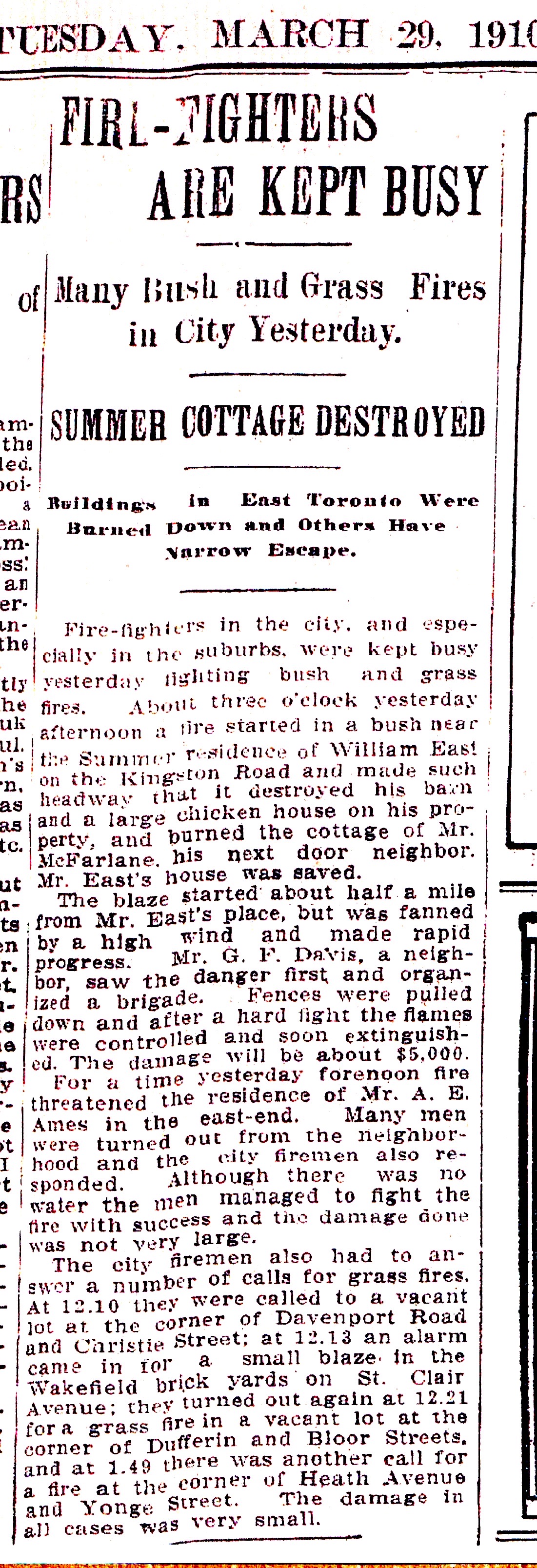
Fire-fighters in the city, and especially in the suburbs, were kept busy yesterday fighting bush and grass fires. About three o’clock yesterday afternoon a fire started in a bush near the Summer residence of William East on the Kingston Road and made such headway that it destroyed his barn and a large chicken house on his property, and burned the cottage of Mr. McFarlane, his next door neighbour. Mr. East’s house was saved.
The blaze started about half a mile from Mr. East’s place but was fanned by a high wind and made rapid progress. Mr. G. F. Davis, a neighbour, saw the danger first and organized a brigade. Fences were pulled down and after a hard fight the flames were controlled and soon extinguished. The damage will be about $5,000.
For a time yesterday forenoon fire threatened the residence of Mr. A. E. Ames in the east-end. Many men were turned out from the neighbourhood and the city firemen also responded. Although there was no water the men managed to fight the fire with success and the damage done was not very large.

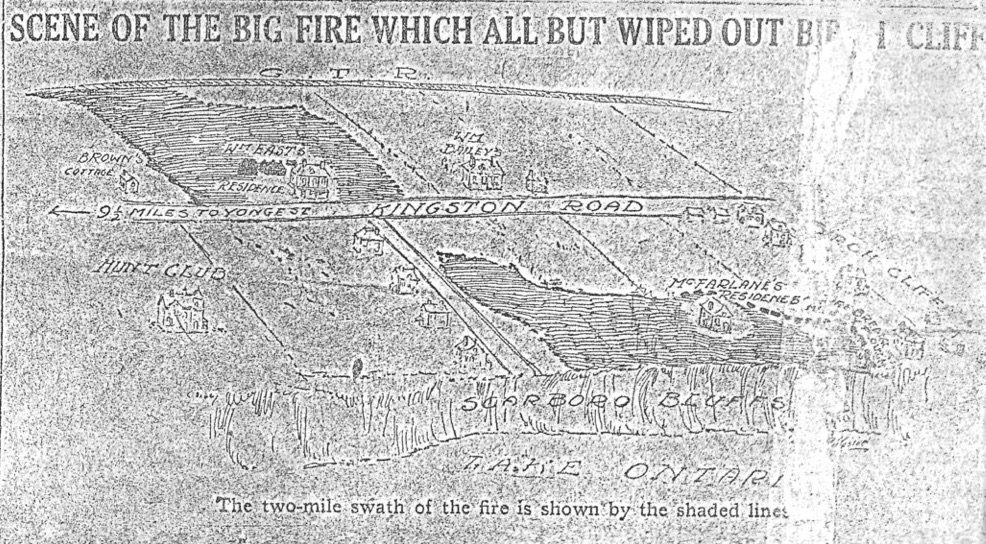
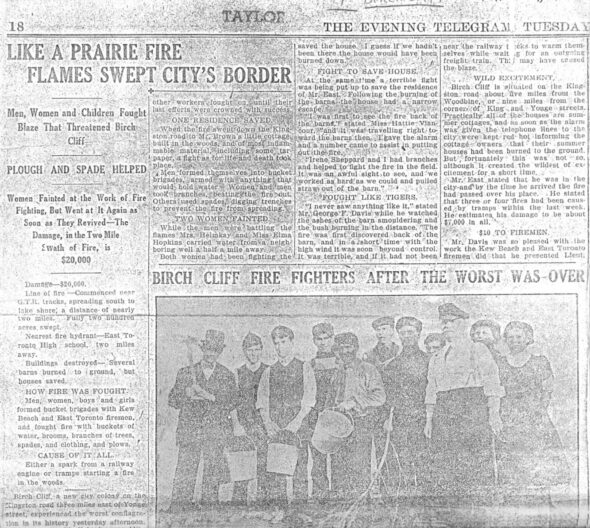
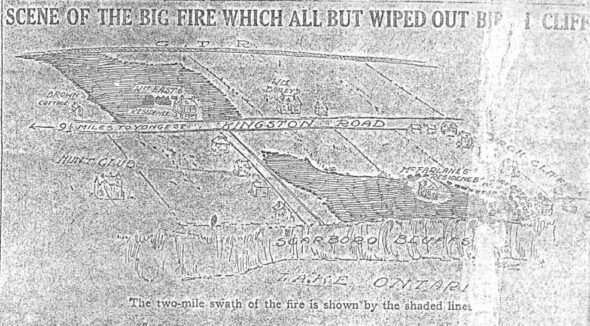
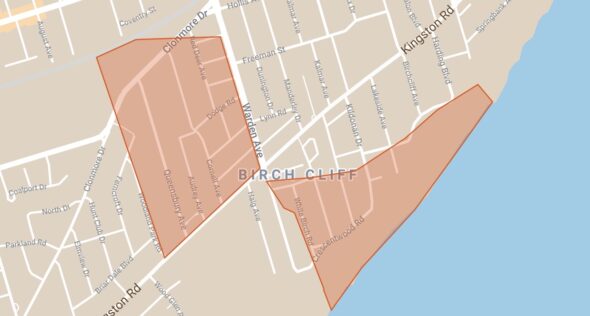
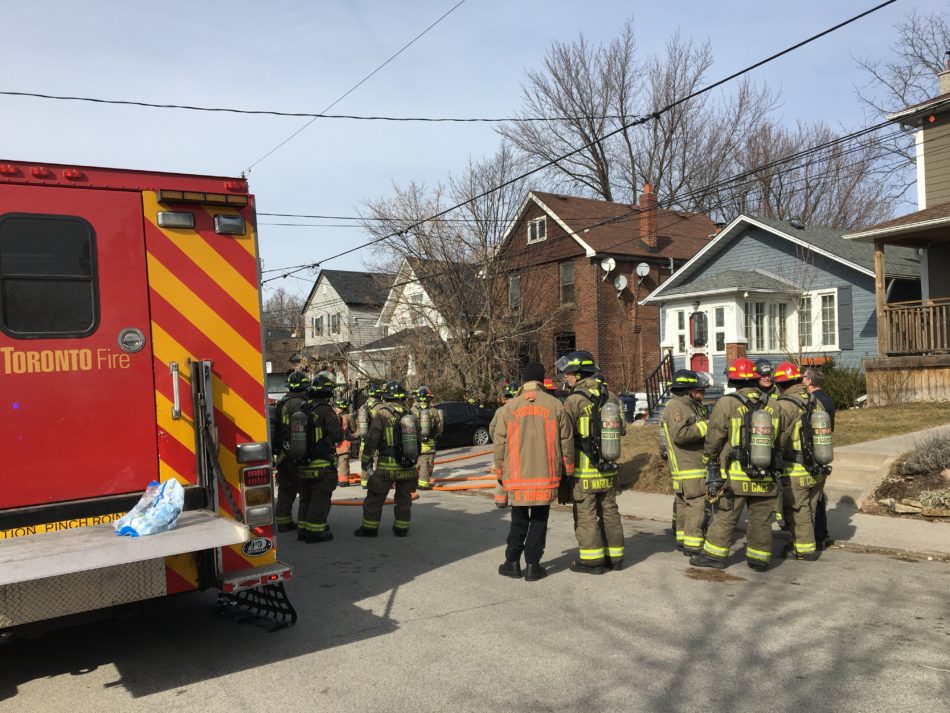
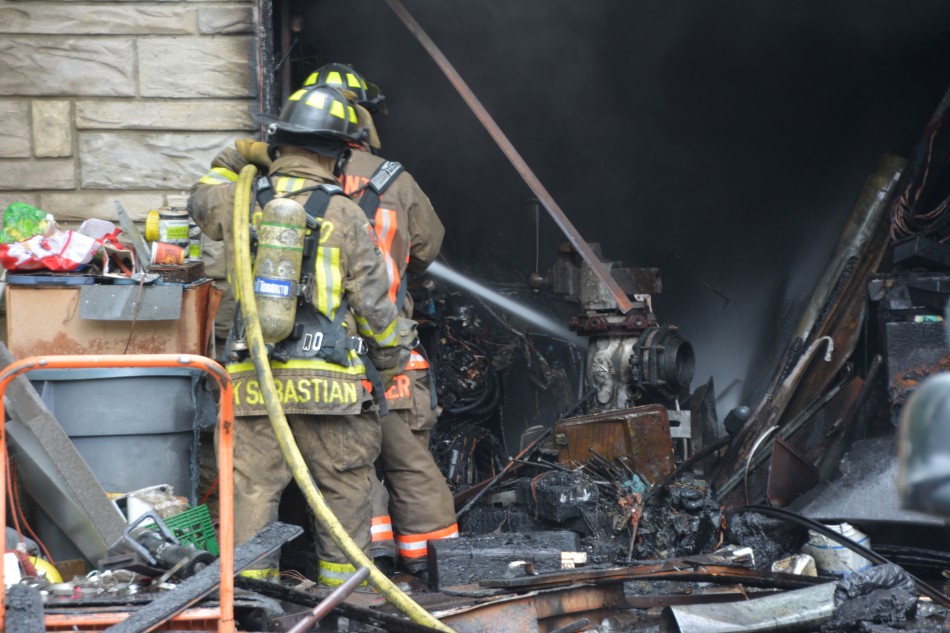
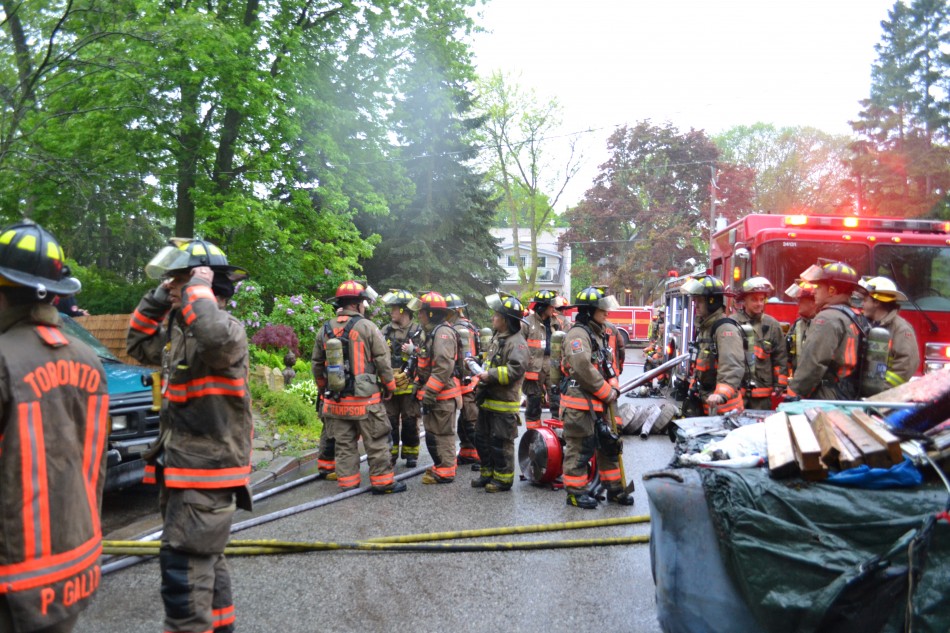
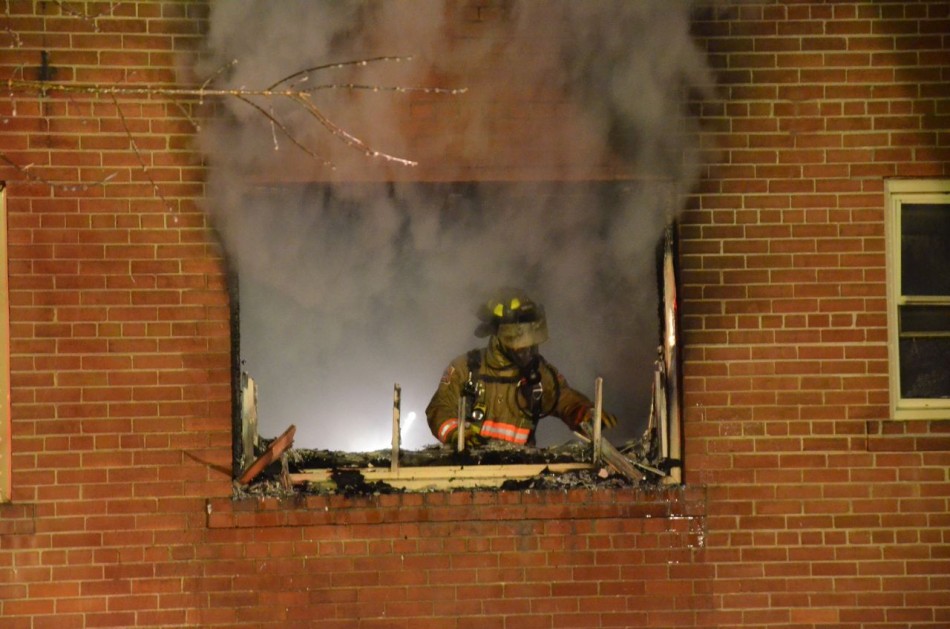

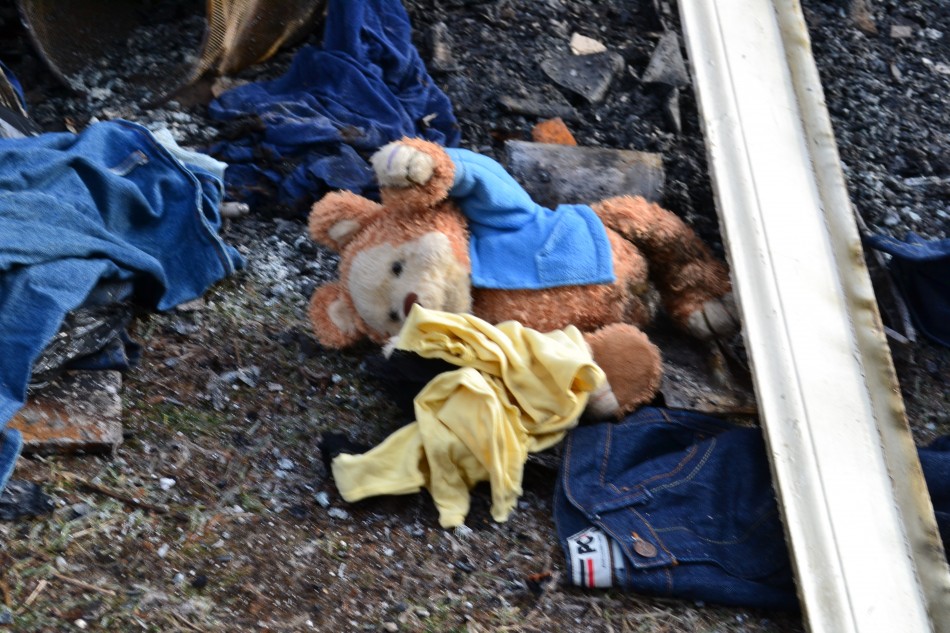
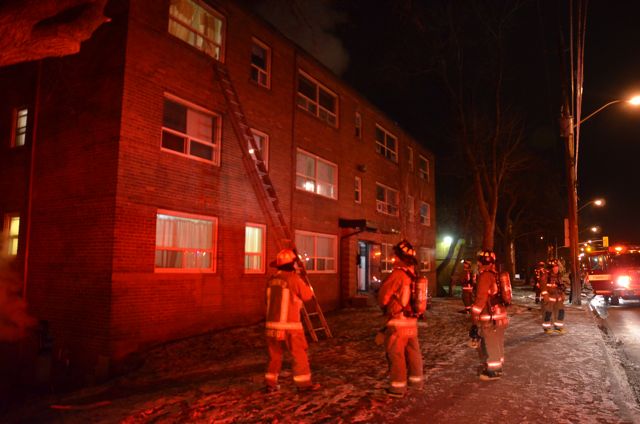
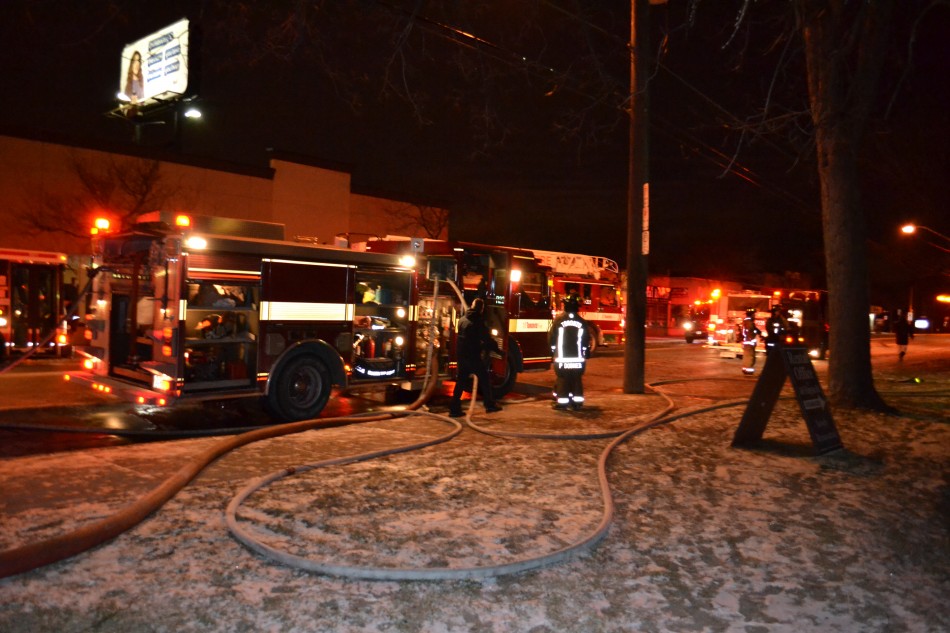
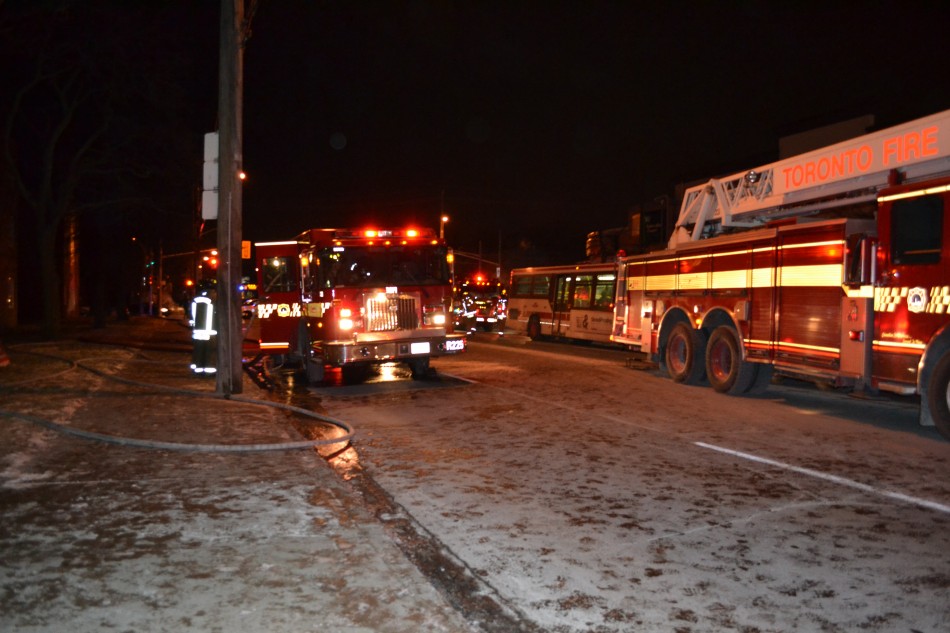

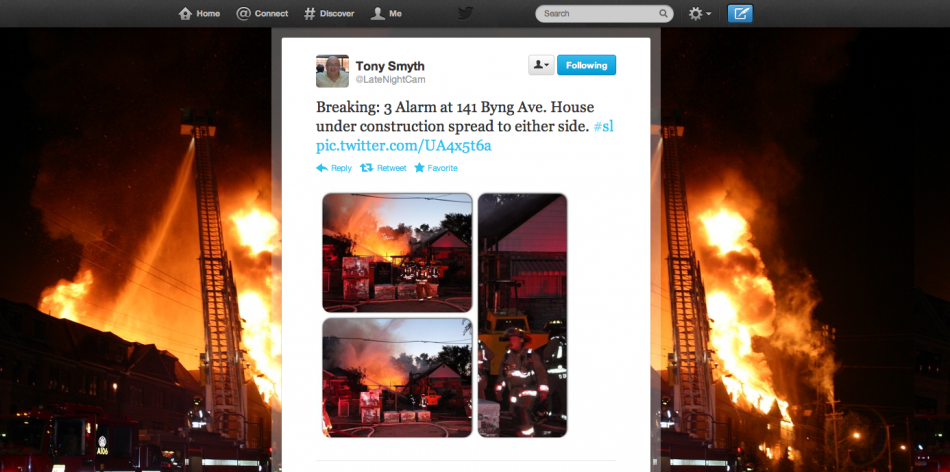
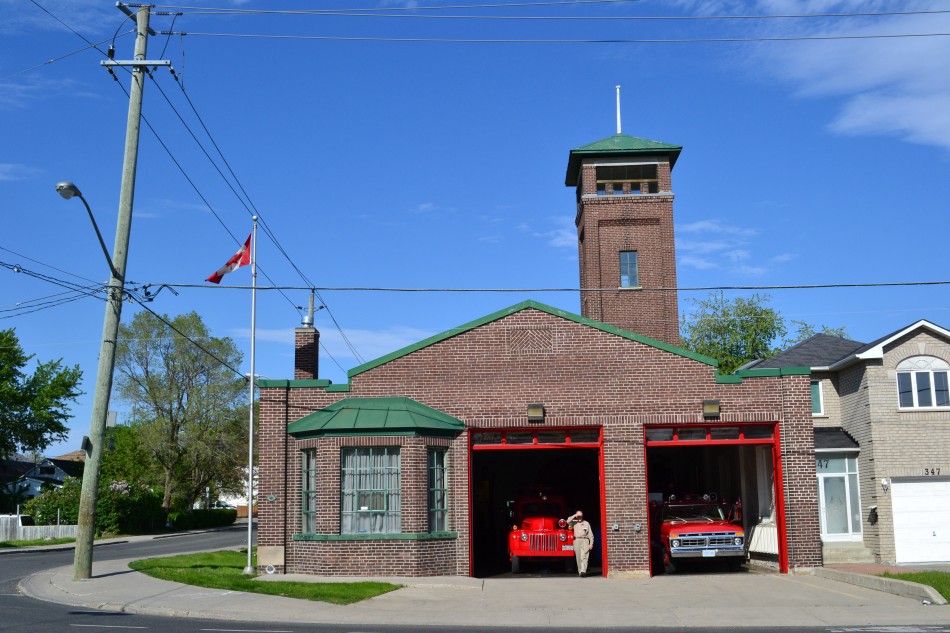
Not surprisingly perhaps, 60 years later the Telegram spawned the Sun.
Still, nothing like a ripper yarn.
The goal was to sell newspapers, not provide a sleeping aid.
I’m sure the good people of Birchcliff who lived it saw it as a life or death struggle.
What ever happened to that reporter I wonder?
Great post. Thanks!!